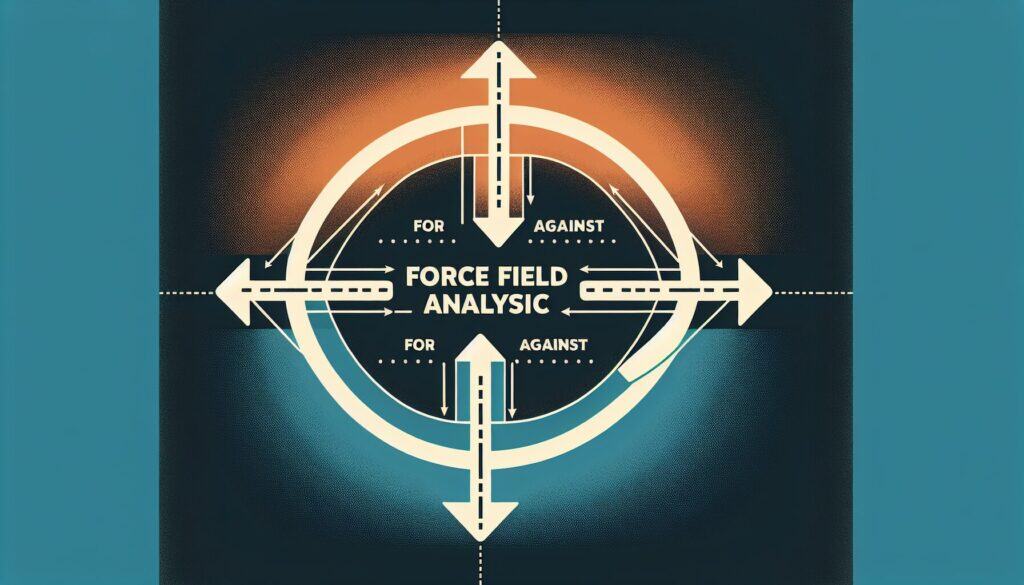Analizar las fuerzas a favor y en contra de un cambio propuesto.
- Metodologías: Ingeniería, Calidad
Análisis del campo de fuerzas

Análisis del campo de fuerzas
- Gestión del cambio, Mejora continua, Mejora de procesos, Gestión de proyectos, Gestión de calidad, Gestión de riesgos, Análisis DAFO, Trabajo en equipo
Objetivo:
Cómo se utiliza:
- Herramienta de toma de decisiones que consiste en identificar las fuerzas impulsoras (factores que apoyan el cambio) y las fuerzas restrictivas (factores que se oponen al cambio). A cada fuerza se le suele asignar una puntuación, y el análisis ayuda a elaborar estrategias para reforzar las fuerzas impulsoras y debilitar las fuerzas restrictivas.
Ventajas
- Proporciona un resumen visual claro de los factores que influyen en un cambio; Ayuda a comprender las complejidades de una iniciativa de cambio; Facilita el debate y la creación de consenso; Ayuda a desarrollar estrategias para gestionar el cambio con eficacia.
Contras
- Puede ser subjetivo a la hora de identificar y puntuar las fuerzas; puede simplificar en exceso situaciones complejas; no ofrece una solución definitiva, sino sólo un marco para el análisis; el proceso de cuantificación de las fuerzas cualitativas puede resultar complicado.
Categorías:
- Recursos Humanos, Resolución de problemas, Gestión de proyectos
Ideal para:
- Tomar decisiones sobre un cambio propuesto identificando y evaluando sistemáticamente los factores que lo apoyarán o dificultarán.
Force Field Analysis is widely applied across various sectors such as healthcare, education, manufacturing, and software development during the planning and implementation phases of projects that involve change initiatives. This methodology is typically initiated by project managers, change agents, or team leaders who seek to drive significant modifications, like the introduction of new technologies or reforms in organizational policies. It is valuable during the early stages of projects when understanding stakeholder perceptions is essential for success or when conducting impact assessments related to potential changes. Participants in these discussions often include cross-functional teams comprising engineers, designers, business analysts, and end-users, ensuring diverse perspectives are represented. By quantifying driving and restraining forces, teams can visualize the balance of power influencing the change process, which aids in facilitating open dialogue for consensus-building. For example, in an engineering context, Force Field Analysis may be employed during the design phase of a new product to weigh the benefits of cutting-edge materials against potential production challenges, enabling more informed decision-making. Furthermore, it supports strategic planning by allowing organizations to formulate actionable steps to bolster supportive factors while mitigating resistance, thus increasing the likelihood of successful implementation within a structured gestión del cambio framework.
Pasos clave de esta metodología
- Clearly define the change initiative or decision to be analyzed.
- Identify and list all driving forces supporting the change.
- Identify and list all restraining forces opposing the change.
- Assign scores to each driving and restraining force according to their impact.
- Create a visual representation of the driving and restraining forces.
- Analyze the balance of forces to understand potential outcomes.
- Develop strategies to strengthen driving forces and mitigate restraining forces.
- Implement the strategies and monitor the effects on driving and restraining forces.
Consejos profesionales
- Incorporate stakeholder feedback throughout the Force Field Analysis process to refine the understanding of driving and restraining forces.
- Use a scoring system that quantifies the strength of each force, enabling data-driven discussions about prioritization and strategy development.
- Regularly revisit and update the Force Field Analysis to adapt to changing internal and external factors that may influence the change initiative.
Leer y comparar varias metodologías, recomendamos el
> Amplio repositorio de metodologías <
junto con otras más de 400 metodologías.
Sus comentarios sobre esta metodología o información adicional son bienvenidos en la dirección sección de comentarios ↓ , así como cualquier idea o enlace relacionado con la ingeniería.
Contexto histórico
1902
1907
1915
1915-11
1918
1920
1922
1902
1904
1913
1915
1916
1919-05-29
1920
1924
(si se desconoce la fecha o no es relevante, por ejemplo "mecánica de fluidos", se ofrece una estimación redondeada de su notable aparición)















Publicaciones relacionadas
Gestión de operaciones de fabricación (MOM)
Sistema de Ejecución de Fabricación (MES)
Plan de control de la fabricación
Pruebas manuales
Tablas de evaluación de la manipulación manual (MAC)
ManTRA (Herramienta de evaluación de riesgos en las tareas manuales)